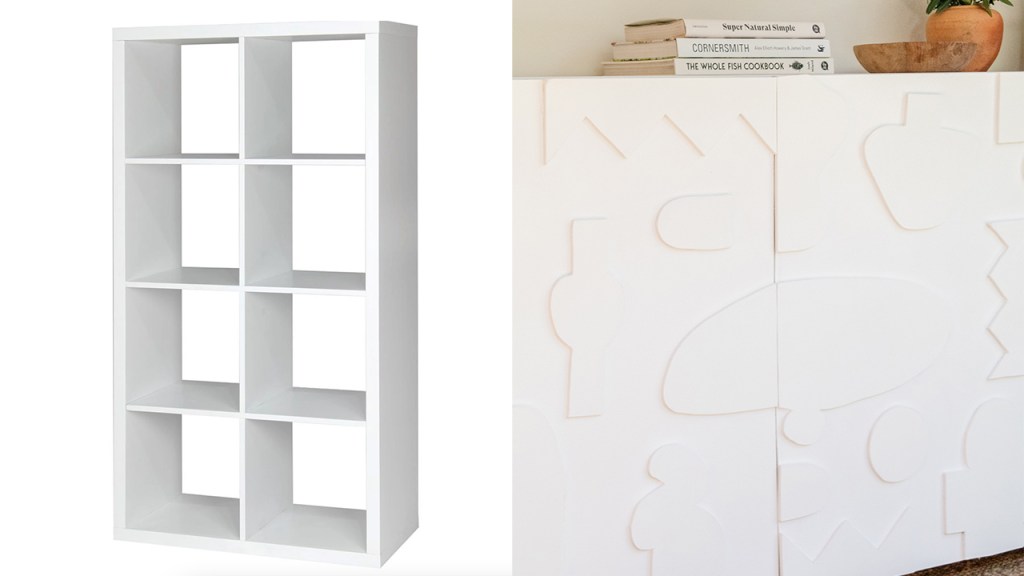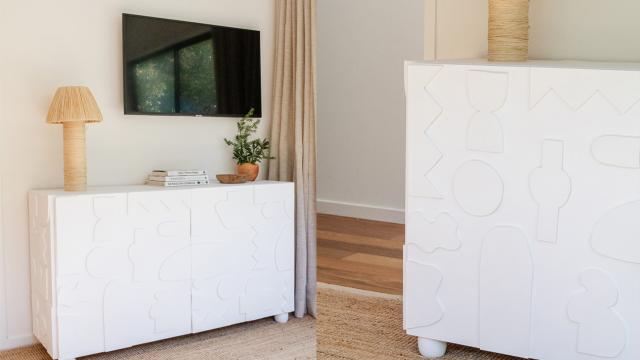We’re lovers of a little DIY project here at Lifehacker Australia, which naturally means that Bunnings is our Disneyland. (You get it.) Recently, DIY pro Jaharn Quinn put her creative mind to work and managed to turn a storage cube unit into an abstract cabinet. Yes, it requires a bit of time and elbow grease but it’s nothing a fellow DIY fan can’t tackle with a little patience.
If you are keen to learn precisely how one might turn a storage cube unit into a cabinet, here is a step by step guide from Quinn herself.
Grab your overalls and get ready for a little home improvement, folks.
How to DIY yourself a new cabinet

If you’re going to be undertaking this storage cube unit to cabinet transformation, there is a list of items you will need first. Here, Quinn and Bunnings have shared what to add to your shopping trolley.
What you’ll need:
- Flexi Storage Clever Cube 76 x 39 x 146cm 2 x 4 Storage Unit – White $95.00
- 2440 x 1220 mm 3mm Melamine White MDF $32.70 – Cut to size to enclose the back of the cabinet
- Trojan 3 in 1 Heavy Duty Staple Gun Set $19.99
- 1200 x 897mm 7mm Plywood Pine Premium BC Grade $35.15 – Cut to size for the two cabinet doors using Bunnings cutting service
- 2x Kaboodle Soft Close Door Hinge – 1 Pair $17.40
- 1x Craftright Carpenters Pencil with Sharpener $4.99
- 4x Adoored 70mm Pine Ball Furniture Leg $6.40
- Selleys Liquid Nails 80g Clear Construction Adhesive $11.49
- ScotchBlue 24mm x 55m Original Multi-Surface Painter’s Masking Tape $7.85
- Zinsser 470ml B-I-N Primer Sealer Stain Killer $29.45
- Dulux 1L Exterior Paint Weathershield Low Sheen Lexicon Quarter $46.90
- Ryobi 18V ONE+ Home Essentials Kit $169.00 – Kit includes Drill, Hammer, Screw Driver and Measuring Tape which will be required for this project
- XUI 350W Jigsaw $29.98
- XU1 125W Detail Sander $29.98
- Clamps
- Paint Rollers
- Paint Tray
- Paint Brushes
Now that you have your tools, you can begin the process of building your new cabinet. Here are Quinn’s steps on how to do that.
Directions for creating your cabinet:
- Begin by assembling the cube storage. *Assembly instructions are listed on the product’s page on the Bunnings website.
- Measure the width and height of the cabinet, and divide this into 2 to get the measurements for the two cabinet doors. Have your cabinet doors and plywood cut to size at your local Bunnings store.
- Attach the melamine MDF (white side facing in) to the back of the storage cube using the staple gun.
- Paint the cabinet doors and once dry, then lift the storage cube onto your work surface placing it on its side.
- Attach the hinges to the storage cube and cabinet doors using these instructions from Bunnings. *Please note the cabinet doors used in this video already have a hole cut out in them.
- Use a pencil to mark where you need to cut a hole.
- Use a drill to make lots of small holes, then use a hammer to bang the plywood out. *Refer to Quinn’s Reel on Instagram for the process.
- Use a screwdriver to lift or drop the doors down, pulling them left or right where/if necessary. By this point, the basic structure of your cabinet should be in place.
- Attach the furniture legs onto the underside of your new cabinet using a drill. If you find the legs are a little loose, use Liquid Nails and let it dry overnight.
- Using a pen, draw the outline of a range of various abstract shapes and cut them out using a jigsaw. Smooth the edges down using a sander.
- Position the abstract shapes onto the cabinet and glue them down using Liquid Nails. The shapes may slip on the sides of the cabinet so use painter’s tape to hold them into place, and let the glue dry overnight.
- Once the glue has dried, paint the furniture legs before standing the cabinet upright.
- Paint the cabinet doors, ensuring you apply multiple coats to hide the MDF.
- While the paint is drying, apply one coat of Zinsser B-I-N Primer Sealer to the sides and top of the cabinet.
- Once dried, apply a couple of coats of white paint and set it aside to dry.
If you’d like to see Quinn’s creative process in action, you can watch the full video below.
Who’s game to give it a try?

Leave a Reply
You must be logged in to post a comment.